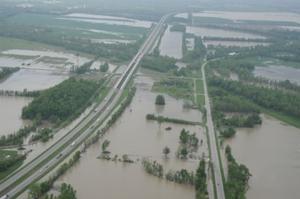FloodsMissouri levee blast floods 130,000 acres, but saves Illinois city
On Tuesday, the U.S. Army Corps of Engineers blasted a section of a levee along the Mississippi River to create a controlled breach that would relieve pressure and prevent the town of Cairo, Illinois from becoming engulfed in record flood levels; the blast created a gap more than 10,000 feet wide at Birds Point, Missouri levees and inundated more than 130,000 acres of farmland; heavy rains have left the Mississippi and Ohio Rivers swollen, putting Cairo and its 3,000 residents at great risk as it sits on a narrow stretch of land between the two surging rivers; on Monday, the Corps received permission from the federal government to go ahead with its plan, despite Missouri’s protests

Some of the 130,000 flooded acres after levee blasting // Source: cbslocal.com
On Tuesday, the U.S. Army Corps of Engineers blasted a section of a levee along the Mississippi River to create a controlled breach that would relieve pressure and prevent the town of Cairo, Illinois from becoming engulfed in record flood levels.
The blast created a gap more than 10,000 feet wide at Birds Point, Missouri levees and inundated more than 130,000 acres of farmland. By blowing up the levee, engineers sought to increase the Mississippi River’s capacity to handle the rapidly rising waters of the Ohio River. Heavy rains have left the Mississippi and Ohio Rivers swollen, putting Cairo and its 3,000 residents at great risk as it sits on a narrow stretch of land between the two surging rivers.
Breaching the levees has resulted in $314 million in estimated damages, but local authorities in Missouri, Illinois, and Kentucky would have faced more than $1.7 billion in damage if engineers had not relieved pressure along the river and let waters top the levees or break through entirely.
In a statement Colonel Vernie Reichling, the commander of the Corps’ Memphis District, said, “We executed the plan and it performed as expected.”
The colonel added, “We are now moving to the next steps, which are opening the two outflow crevasses at the southern end of the floodway.”
Several hours after a barge laden with explosives was detonated, water levels near Cairo fell to 60.51 down from a high of 61.72 feet. By 7 May levels are expected to continue to drop to 59.4 feet, which is still far above the 40 foot flood plain.
The National Weather Service does not project any respite for the hard hit region as it forecasts a total of five inches of rain over the next several days.
“That sort of sustained crest puts an enormous amount of pressure on the entire system,” said Colonel Reichling.
On Monday, the U.S. Army Corps of Engineers received permission from the federal government to go ahead with its plan, despite Missouri’s protests.
The attorney general of Missouri filed several official complaints, but Supreme Court Justice Samuel Alito turned down the state’s request.
The decision has created tension between farmers in Missouri and the predominately African-American residents of Cairo, a city is littered with vacant buildings and that has been stung by poverty and drug abuse.
The 200 residents of Missouri who live along the federally mandated floodplain were not pleased.
Dorian Weems, a resident of Missouri who lives near the flood wall, said, “Farmland over people? That’s ridiculous.”
“I think it’s a money thing. If Cairo gets flooded, they ain’t losing much — it’s just a bunch of low-income people there, so it doesn’t matter,” he added.
The decision to blow the levees and flood farmland was not taken lightly by the Corps.
Russ Davis, the chief of the corps’ Operations Division, said, “These are people’s homes, their livelihoods. We really don’t want to do this.”
Sheriff Keith Moore of Mississippi County lamented, “It’s going to take out one-third of my county — that’s a lot of good people with lots of history here.”
Moore added, “It’s going to be a tsunami for Mississippi County, but what I say isn’t going to make a difference. It’s one man’s call.”
